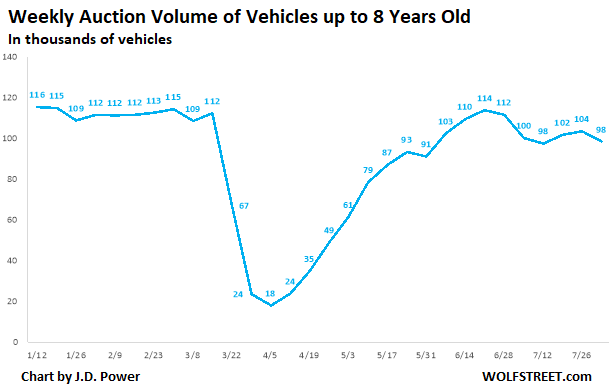Used Car & Truck Market Turmoil Mauls Freshly IPO-ed Unicorn Online Car Dealer Vroom. Shares -20%
by Wolf Richter, Wolf Street:
 And how did the pros at CarMax do in the Crisis?
And how did the pros at CarMax do in the Crisis?
Vroom, whose shares plunged nearly 20% afterhours today, belongs to a new breed of used-vehicle dealers that sell cars online. On the first day of trading after its IPO two months ago, amid a crazy surging stock market, its shares “popped” 117%. From the IPO price of $22, shares then soared to a closing high today of $69.01, before the afterhours plunge to $55.56 a share.
Back in the day, we said that if you can’t make money selling used cars, you can’t make money in anything. But this new breed of used-car dealers – because they’re ecommerce tech companies or something, and not car dealers – are walking on water and don’t need to make money. So they’re losing money relentlessly, selling used cars. But this time around, it was particularly bad.
Buying a used car online and having it delivered is still not common in the US. About 0.9% of total used vehicle sales occur online, according to Vroom’s Prospectus filed before its IPO. So change is afoot. But good lordy. This is how much Vroom has been losing, selling used cars:
- In 2018: lost $98 million on $855 million in revenues.
- In 2019: lost $276 million on $1.19 billion in revenues
In the first half of 2020, it lost $104 million on $629 million in revenues. Compared to the first half in 2019, the loss was up 72% and revenues were up 27%.
You see where this is going: the more it sells, the more it loses, and this in the used-car business.
But Q2 was special: Supply shock & demand shock.
In its report today, Vroom said – and this is interesting:
“In response to the drop in demand and uncertainty around vehicle pricing early in the pandemic, we chose to de-risk the business by significantly reducing our inventory during the first half of the quarter.”
OK, Vroom is into ecommerce and wasn’t impacted by the lockdown in March and April, but people stopped buying used cars, and Vroom, along with the entire industry, stopped replenishing their inventories and stopped going to the auctions and stopped buying more used cars. And they sold what they had to trim down their inventory, and they made deals to get rid of these cars.
But then the stimulus checks hailed down on consumers and made great down-payments for auto loans, and suddenly people were buying used cars again. And so Vroom went on:
“As demand increased and pricing became more stable through the second half of the quarter, we pivoted to start rebuilding inventory and continue to do so.”
Vroom went out there buying used cars so that it would have something it could sell. And this happened nationwide. But it was too late:
“These lower inventory levels prevented us from fulfilling all of the demand that materialized in the second half of the quarter.”
They all did the same thing at the same time.
Before the Pandemic, between 109,000 and 116,000 used vehicles, up to eight years old, were sold every week at auctions around the country, according to J.D. Power. But sudden, in mid-March, volume collapsed, and by the week through April 5 was down 84%, to just 18,000 units, as the market had frozen up, with dealers not buying and sellers not sending their vehicles to the auction, and auctions shutting down because of safety concerns.
Then auctions transitioned to electronic venues and figured out social distancing. Dealers showed up again, and sellers showed up again, and volume soared to pre-Pandemic levels. This chart of weekly auction volume from J.D. Power shows this chaos, the 84% plunge, the bounce-back, and the tapering off again as dealers largely finished replenishing their inventories:
During the freeze-up, used-vehicle wholesale prices dropped, and then during the bounce-back, wholesale prices surged and hit record highs in July, but those price increases appear to be tapering off now.
Surging wholesale prices mean higher costs for dealers, which squeezes their profit margins when they retail the units. But that impacts all dealers, not just Vroom.


